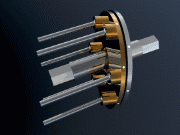
A swashplate, also known as slant disk, is a mechanical engineering device used to translate the motion of a rotating shaft into reciprocating motion, or vice versa. The working principle is similar to crankshaft, Scotch yoke, or wobble, nutator, and Z-crank drives in engine designs. It was originally invented to replace a crankshaft, and is one of the most popular concepts used in crankless engines. It was invented by Anthony Michell in 1917.[1][2]
- ^ Australia 4627, Michell, Anthony George Maldon, published 1917
- ^ Anning, John A. "The "Michell" Crankless Engine – Why was it not a commercial success?" (PDF). Archived from the original (PDF) on 2017-12-01.